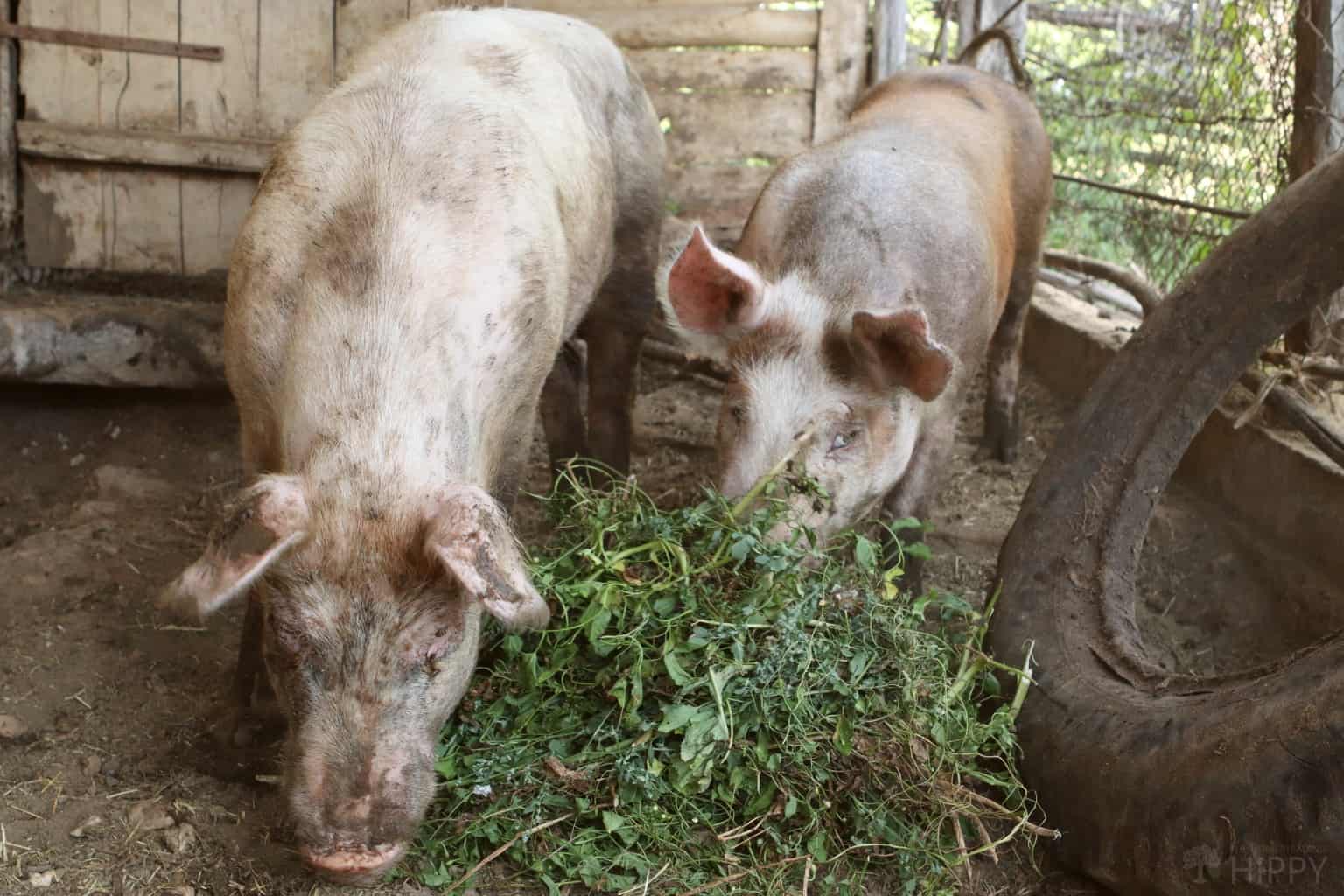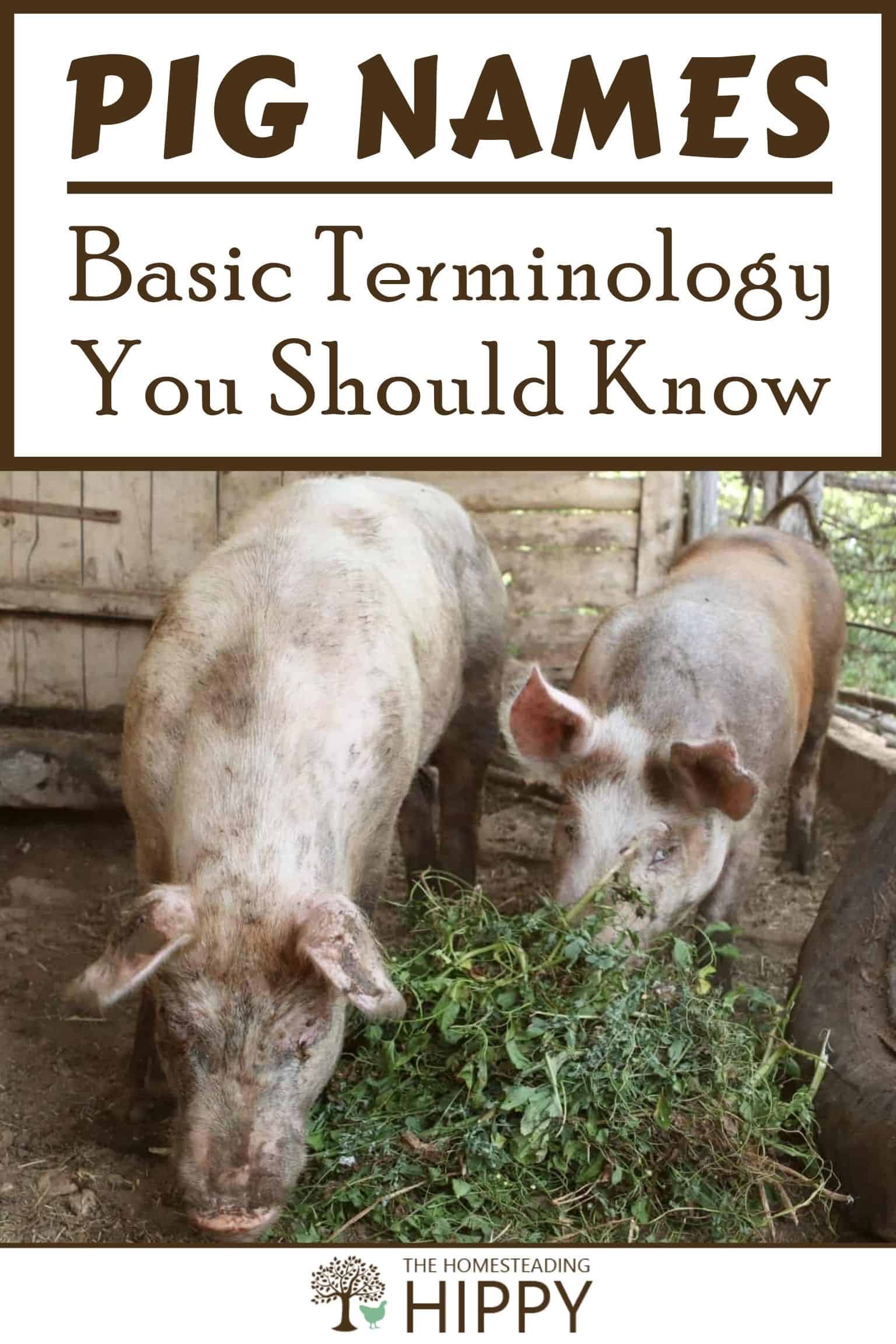If you spent any time around a farm or around anyone who raises pigs, you’ve probably already noticed that there is an awful lot of special terminology and lingo associated with them. So much, in fact, it almost sounds like two pros can be speaking a different language!

It might sound sort of intimidating to newbies, but it’s easy to learn, and learn it you should. To help you sound like a seasoned hand at raising pigs, I’m bringing you some of the most needed terminology you should know…
What are Male Pigs Called?
Male pigs can be referred to as boars, hogs or barrows, and there are big differences between them, outlined just below.
But in short, male pigs are called boars or hogs or barrows depending on their reproductive status…
What is a Boar?
A boar is an uncastrated male pig that is used for breeding purposes. They are usually larger than other pigs of like breed, and have distinct physical characteristics such as longer snouts, tusks, and a more muscular build.
Boars, including domestic animals, are known for aggressive behavior, especially during mating season when they can become territorial and pose a threat to humans.
What is a Barrow?
On the other hand, a barrow is a castrated male pig that has been neutered before reaching sexual maturity. As a result, they do not produce sperm and are useful for breeding.
They also tend to be smaller and “softer” in their features compared to boars since they lack testosterone supplied by the testes.
Barrows are often raised for meat production because they don’t develop the strong, “gamey” flavor that is sometimes associated with boars.
They are also typically far more docile and easier to manage than their uncastrated counterparts.
What is a Hog?
Hog is just another term for barrow, if used with precision. It might also be a generic term for any fully mature pig, and is sometimes used colloquially to describe pigs over a certain weight, or pigs that have attained a certain age.
Hog may also be used as a catch-all term for any pig that is ready for slaughter. Not a very accurate term in most contexts, and can be confusing depending on who you’re talking to!
What are Female Pigs Called?
Female pigs have different names, too, depending on their reproductive status, just like the guys. Only compared to the guys, females often get to keep their parts!
What is a Gilt?
Young non-breeding female pigs are called gilts, while females that have given birth to litters of piglets are called sows.
Gilts are typically between six months and a year old and have not yet had a litter of piglets.
Gilts are still often intended for breeding since they have not yet been impregnated and can produce several litters over their lifetime.
What is a Sow?
Sows, on the other hand, are female pigs that have officially given birth to at least one litter of piglets, and sometimes the term is applied to any female pig that is one year old or older.
Sows require extra special care during breeding and pregnancy to ensure that both the mother and piglets are healthy.
After giving birth, sows are often separated from their piglets to prevent accidental crushing, but they are later responsible for nursing and caring for their young until they are weaned.
What are Baby Pigs Called?
Everyone knows this one, and I just gave away the answer above: baby pigs are more properly called piglets.
Piglets are called, well, piglets until they are weaned, which can occur anywhere from three weeks to eight months or so after birth.
A piglet’s gender doesn’t have any bearing on what it is called; whether male or female, piglets are still referred to as piglets.
What is a Weaner?
A weaner, pronounced wiener as in hot dog, is any piglet that has been separated from its mother and is it beginning to be fed solid food.
Since piglets maybe weaned much earlier or much later depending on the objectives of their owners, weaner is not necessarily a term that will let you judge the age of a young pig.
What is a Shoat?
Immature piglets that are weaned might be called shoats, or “shotes,” in American English. This is a term that has fallen out of usage in some places, but may still be used to refer to them.
What is a Swine?
Swine is not a name so much as a catch-all term that refers to pigs, broadly, be they wild or domesticated.
This term can be used colloquially or in the context of an academic topic to refer to pigs as a species, and it is often applied when discussing diseases like swine flu, or best practices in swine management.
Swine is also a term used to refer to pigs in the culinary sense, such as “pork,” which is the meat of a pig that has been slaughtered for human consumption.
Regardless of what you call them otherwise, swine as a term applies if you are talking about pigs as a category!
What is a Growing-Finishing Pig?
A growing-finishing pig is one that weighs between 40 and 220 lbs. It is a pig that is not being raised for breeding purposes, but instead for slaughter.
What’s a Feeder Pig?
A feeder pig is a young gilt or barrow that is typically between 40 and 80 pounds. Feeder pigs are raised for meat production and are sold to farmers and ranchers who specialize in finishing them for slaughter.
Feeder pigs are usually produced by specialized breeding farms that focus on producing high-quality genetics for meat production.
Once they are weaned from their mothers, the feeder pigs are transported to other farms or facilities where they’re raised until they reach market weight.
What’s a Grower Pig?
A grower pig is a young pig that has been weaned and is being raised specifically for meat production, one that weighs between 40 and 125 pounds.
This stage of growth occurs between the weanling stage and finishing stage, where the pig reaches market weight.
Grower pigs are usually between 10 weeks and six months old, depending on the breed, and need regular health checks to prevent the spread of disease and ensure that they reach market weight on time.
What is a Porker?
Porker is a generic nickname for all kinds of pigs of any age, but used among professionals and enthusiasts who raise pigs this refers to any pig that is intended to be slaughtered for its meat. There are several subcategories of a porker you should know, listed below.
What is a Cutter Pig?
A cutter is any porker that is intended to be cut up into large cuts of meat, or primal cuts in particular.
If someone is buying a whole rack of hog or a whole leg, they probably got it from a cutter. Sometimes used to refer to younger pigs generically.
What is a Baconer Pig?
I hope you can figure this one out: a baconer is any porker that is being raised predominantly for the production of delicious, life-sustaining bacon!
What’s a Feral Pig?
Feral pigs, also known as feral hogs, wild pigs, or wild hogs, are domestic pigs that have escaped captivity and reverted to a wild state.
The terms feral pigs, feral hogs, wild pigs, and wild hogs are often used interchangeably because they refer to the same animal.
However, some people may use one term more than the others depending on their location or cultural background.
Are Feral Pigs the Same as Wild Hogs?
It is important to note that while feral pigs may look similar to true wild species, such as boars or javelinas, there are some differences.
Domestic pigs were bred for specific traits such as docility and meat quality, while wild pigs have evolved to survive in their natural environment. Feral pigs may interbreed with their wild cousins, producing unique hybrids.
Nevertheless, feral pigs and true wild pig species share lots of similarities: both develop tusks, are typically aggressive and territorial, both cause significant damage to crops, natural habitats, and can even pose a threat to human safety.
What is a Razorback?
A razorback is a nickname for a wild hog, typically a male since they often have a very pronounced ridge of bristly guard hair going down their spine.
When agitated or alerted, these hairs tend to stand up just like the hairs of a cat, and it almost looks like a blade is running from the base of their neck down their back.
Hence, razorback! This term is also sometimes used to refer to any large and aggressive male pig.
What is a Runt?
A runt is any piglet that is smaller or weaker compared to its litter mates. These pigs can survive, and don’t need to be culled from the herd.
Make sure the mother sow has plenty of teats to feed all of the pigs. If she does, then you don’t need to worry about the runt accessing food. If she doesn’t, you will need to transfer some piglets to another sow, or engage in manual feeding.
What’s a Salt Pig?
A salt pig isn’t a pig at all, nor is it another term for salted pork. A salt pig is actually an oblong, open earthenware container for holding salt in your kitchen. That’s it!
What Does “Yield” Mean?
Yield refers to the percentage of the carcass in the four lean cuts – loin, picnic, ham, and Boston butt.
For best yields, select a breed that grows out quickly, such as a Berkshire, and feed your pigs with unique food sources such as brewer’s grain or vegetable scraps to cut down on feed costs.
What Does “Hanging Weight” Mean?
Hanging weight refers to the weight of a pig after it has been gutted and skinned. Live weight, on the other hand, refers to what the animals weighs when it is alive.
The difference between live and hanging weight is usually bout forty percent. Don’t make the mistake of raising your pigs so long that their hanging weight becomes cost ineffective.
A pig will put on about a pound a day until it is about two hundred pounds. From there, its growth will slow considerably.
Choosing a breed with a good feed conversion rate will help maximize this process, but you shouldn’t delay butchering just because your pig might put on more weight.
It will gain weight, but after about six months, this weight gain will slow dramatically and you will end up spending more money in feed than you will reap in meat production.
Most people don’t butcher their own pigs, although you can. If you are a novice, have a butcher dress the pigs and smoke the hams and bacon. They can also make the sausage and other byproducts, like head cheese.

The post Pig Names: Basic Terminology You Should Know appeared first on The Homesteading Hippy.

